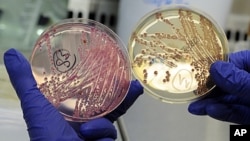The cause of the E. coli outbreak in Germany remains a mystery. The outbreak is the deadliest in modern history with at least two-dozens deaths and more than 2,400 people sickened. Eleven other European nations and the United States also report E. coli cases and say most of the victims had visited Germany.
But some health officials in the United States say it may be just a matter of time before a similar E.coli outbreak happens in the United States.
International medical researchers are racing to find a cause of the world's deadliest E. coli outbreak that began in Germany May 2. Experts have been unable to pinpoint the source of a rare super toxic strain of E. coli bacteria that has killed dozens and sickened thousands. At least four people in America who visited Germany became sick.
Dr. Robynne Chutkan, a Gastroenterologist at Georgetown Hospital in Washington expects more cases in the U.S. soon.
"There is so much international travel between the U.S. and Europe I think it is completely conceivable that in the next few weeks we could be seeing some outbreaks of this potentially new and more virulent strain of E. Coli here in the United States," she said.
|
E. coli and how it is transmitted E. coli is an abbreviation for Escherichia, which is a large and diverse group of bacteria. Most strains are harmless, others can cause illness. Symptoms include stomach cramps, diarrhea and vomiting. The major source is cattle, but other animals, foods and liquids may spread contamination to people.
|
The E. coli outbreak in Germany has left hundreds of people hospitalized with life threatening kidney complications. It comes as U.S. health officials released data showing an increasing number of people were sickened by rare forms of E. coli bacteria in America last year.
Pat Buck is executive director of the Center for Foodborne Illness Research and Prevention. She founded the organization in 2006 after her grandson Kevin died from eating food tainted with E-coli bacteria. Buck says more can be done to improve U.S. food safety standards.
"Look at the connections between humans and animals and environments and see where these things connect because it is through the zoonotic diseases importantly that we end up with foodborne illness," she said.
Dr. Chutkan says the nasty form of E. coli hitting Europe illustrates the need for testing more foods in the United States for rare strains of the bacteria.
"One of the frightening and rather challenging aspects that this outbreak has illustrated is that foodborne illness can affect many different types of food and we thought of E. coli in the past as something that has been more strongly associated with meat but now we are seeing it in produce: tomatoes, cucumbers, potentially sprouts and maybe lettuce," she said.
The U.S. Centers for Disease Control and Prevention has alerted state health departments to the ongoing outbreak and requested information about any people who test positive for the E.coli strain. The Food and Drug Administration has also stepped up testing of foods imported from affected countries. There are also new laws in place requiring the FDA to set standards to guard against all kinds of contamination in fresh produce.
Dr. Thomas Tallman, with the Cleveland Clinic Event Medicine, says the E. coli outbreak in Europe should be a wake-up call for people to take extra steps to properly clean fresh vegetables and fruits.
"I buy one of those sprays you can get at the supermarket that you can spray on them and rinse it off right away. It is not really even a detergent or anything caustic. But it helps just rinsing them, even just rinsing them with water so you have taken off anything that could be on the fruits and vegetables," he said.
The E.coli outbreak in Europe has led to more pressure from consumer groups for U.S. officials to do more testing for other E. colis in beef. They also want more stringent regulation over companies that process beef to prevent E. coli contamination at slaughterhouses.










